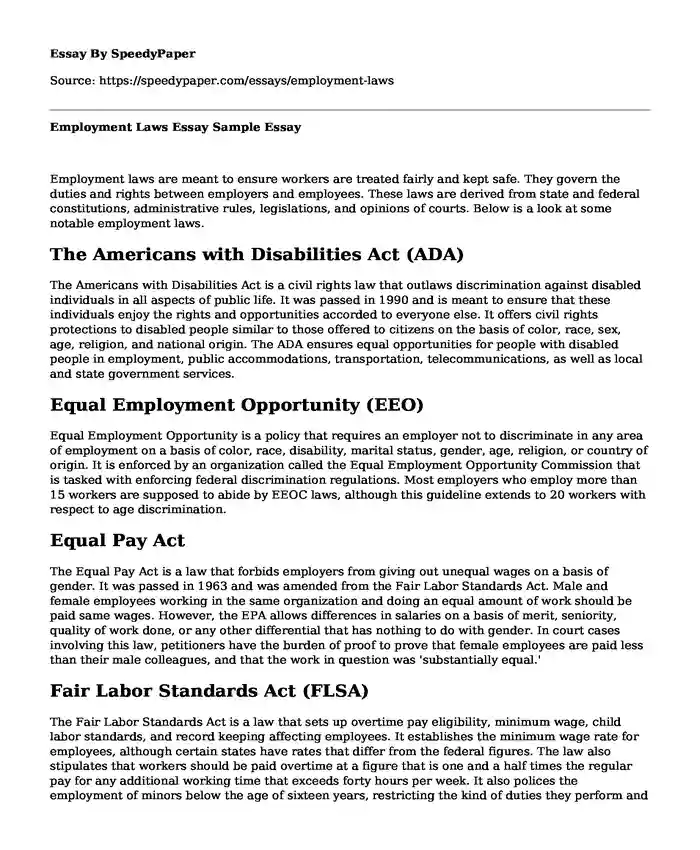
| Type of paper: | Essay |
| Categories: | Employment law |
| Pages: | 3 |
| Wordcount: | 618 words |
Employment laws are meant to ensure workers are treated fairly and kept safe. They govern the duties and rights between employers and employees. These laws are derived from state and federal constitutions, administrative rules, legislations, and opinions of courts. Below is a look at some notable employment laws.
The Americans with Disabilities Act (ADA)
The Americans with Disabilities Act is a civil rights law that outlaws discrimination against disabled individuals in all aspects of public life. It was passed in 1990 and is meant to ensure that these individuals enjoy the rights and opportunities accorded to everyone else. It offers civil rights protections to disabled people similar to those offered to citizens on the basis of color, race, sex, age, religion, and national origin. The ADA ensures equal opportunities for people with disabled people in employment, public accommodations, transportation, telecommunications, as well as local and state government services.
Equal Employment Opportunity (EEO)
Equal Employment Opportunity is a policy that requires an employer not to discriminate in any area of employment on a basis of color, race, disability, marital status, gender, age, religion, or country of origin. It is enforced by an organization called the Equal Employment Opportunity Commission that is tasked with enforcing federal discrimination regulations. Most employers who employ more than 15 workers are supposed to abide by EEOC laws, although this guideline extends to 20 workers with respect to age discrimination.
Equal Pay Act
The Equal Pay Act is a law that forbids employers from giving out unequal wages on a basis of gender. It was passed in 1963 and was amended from the Fair Labor Standards Act. Male and female employees working in the same organization and doing an equal amount of work should be paid same wages. However, the EPA allows differences in salaries on a basis of merit, seniority, quality of work done, or any other differential that has nothing to do with gender. In court cases involving this law, petitioners have the burden of proof to prove that female employees are paid less than their male colleagues, and that the work in question was 'substantially equal.'
Fair Labor Standards Act (FLSA)
The Fair Labor Standards Act is a law that sets up overtime pay eligibility, minimum wage, child labor standards, and record keeping affecting employees. It establishes the minimum wage rate for employees, although certain states have rates that differ from the federal figures. The law also stipulates that workers should be paid overtime at a figure that is one and a half times the regular pay for any additional working time that exceeds forty hours per week. It also polices the employment of minors below the age of sixteen years, restricting the kind of duties they perform and the number of hours they are active.
Occupational Safety and Health Act (OSHA)
The Occupational Safety and Health Act is the main law that deals with worker safety. Passed in 1970, its primary aim is to minimize workplace hazards and put in place safety and health programs targeting employers and their workers. The Act presents employees with several rights including access to training, information on workplace hazards, and strategies for avoiding harm. They also have the right to access and review documents about work-related injuries and illnesses at the workplace. In addition, employees cannot be victimized for making inquiries or filing complaints related to safety.
References
Burnham, W. (2016). Introduction to the law and legal system of the United States. West Academic Publishing.
Dau-Schmidt, K. G., Finkin, M., & Covington, R. (2016). Legal protection for the individual employee. West Academic.
Kalleberg, A. L., Reskin, B. F., & Hudson, K. (2000). Bad jobs in America: Standard and nonstandard employment relations and job quality in the United States. American sociological review, 256-278.
Cite this page
Employment Laws Essay Sample. (2022, Mar 01). Retrieved from https://speedypaper.net/essays/employment-laws
Request Removal
If you are the original author of this essay and no longer wish to have it published on the SpeedyPaper website, please click below to request its removal:
- Felix Longoria's Wake Essay Sample
- Free Essay: Gender and Sexuality in Catcher in the Rye and The House on Mango Street
- HRM Essay Sample: What's More Important: Qualification or Experience?
- Ethical Issues in Malaria Research, Essay Example for Everyone
- Paper Example. Understanding Consumer and Business Buyer Behavior
- The Crisis Deepens: World War II, Free Essay Sample
- Essay Sample on How Social Movements Affect Public Relations
Popular categories




